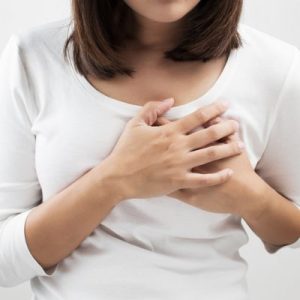Breast Pain (Mastalgia): When Should I Be Concerned?
Breast pain (mastalgia) is one of the most common symptoms reported by women, affecting up to 70% at some point in their lives. Although it often causes concern, most cases are not related to breast cancer.

What is mastalgia?
Mastalgia (or mastodynia) refers to any type of breast pain. It occurs more frequently in older women, those with large or ptotic breasts, and individuals with a sedentary lifestyle. It can negatively impact mood, sleep, sexual life, and daily activities.
Is breast pain associated with breast cancer?
Rarely. Pain is the sole symptom of breast cancer in only 0.5–3.3% of cases. If clinical examination and imaging (ultrasound, mammography) are normal, the risk of malignancy is comparable to that of women without breast pain.
Causes of breast pain
Breast pain is classified into three main categories:
- Cyclical pain (cyclic mastalgia):
Related to the menstrual cycle, affecting about two-thirds of women with breast pain. It appears a few days before menstruation, usually affects both breasts, and is mainly located in the upper outer quadrant near the axilla.
- Non-cyclical pain:
Not related to the menstrual cycle and may be continuous or intermittent, unilateral, and affect any breast area. Possible causes include:
- Breast cysts
- Fibroadenoma or fibrocystic breast disease
- Large breasts
- High-fat diet
- Caffeine or smoking
- Hormone replacement therapy
- Mastitis or duct ectasia
- Inflammatory breast cancer (rare)
- Extramammary pain:
Originates outside the breast but is perceived as breast pain due to shared nerve pathways, including:
- Thoracic wall
- Muscles or ribs (e.g., strain)
- Spine
- Cervical spondylosis
- Respiratory infections
When are investigations needed?
Imaging is indicated when:
- There is bloody or clear nipple discharge
- A palpable breast mass is present
- Nipple retraction or skin changes occur
- Unilateral or persistent pain without obvious cause
In cases of cyclical or bilateral pain without other suspicious symptoms, imaging is often not necessary. However, many women find reassurance after a normal ultrasound or mammogram.
What type of imaging is required?
Imaging choice depends on age:
- Under 30 years: Breast ultrasound
- 30–39 years: Ultrasound ± Mammography ± MRI
- Over 40 years: Mammography + Ultrasound ± MRI
How is breast pain treated?
Most cases do not require surgery. Management starts conservatively:
First-line:
- Proper supportive bra
- Warm or cold compresses
- Anti-inflammatory medications (e.g., ibuprofen, diclofenac, aspirin orally or topically)
If pain persists for over 6 months
, hormonal treatments may be considered:
- Tamoxifen
- Danazol
These medications are prescribed only by specialized breast surgeons due to potential side effects (hot flashes, joint pain, libido changes, vaginal dryness, etc.).
Are there alternative options?
Although scientific evidence is limited, the following may be beneficial:
- Low-fat diet
- Caffeine avoidance
- Vitamin E supplements
- Oils rich in linoleic acid (e.g., evening primrose oil)
For extramammary pain, treatment focuses on the underlying cause (e.g., muscle strain, spondyloarthritis).
Conclusion
Breast pain is a common but mostly benign symptom. It is rarely associated with breast cancer but requires appropriate evaluation by a specialist. Proper assessment and individualized advice from a breast surgeon can provide reassurance and relief.
At breastaware.gr
At breastaware.gr , you will find reliable information about all aspects of breast health, with respect for women and a focus on prevention, education, and early diagnosis.
Bibliography:
- Ader DN, South-Paul J. Breast pain: clinical patterns and etiologic considerations. Obstet Gynecol Clin North Am. 1994;21(3):433–460.
- Kataria K, Dhar A, Kumar S, Goyal A. Aetiology of mastalgia: A systematic review. Int J Surg. 2015;15:106–114.
- National Institute for Health and Care Excellence (NICE). Breast pain. Clinical Knowledge Summaries. 2023.
- Mansel RE, et al. Mastalgia: management and guidelines. Eur J Surg Oncol. 1994;20(2):112–116.
- Khosravi P, et al. Evening primrose oil for mastalgia: a systematic review. Breast Dis. 2020;39(1):25–32.
- Khan SA, Apkarian AV. Mastalgia and breast pain: a common complaint. Int J Womens Health. 2021;13:447–456.
